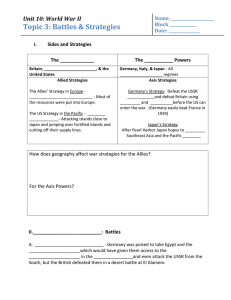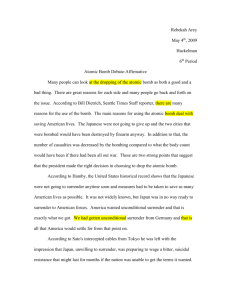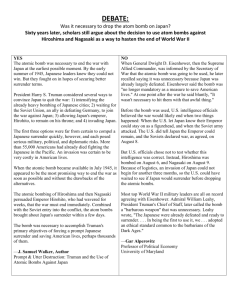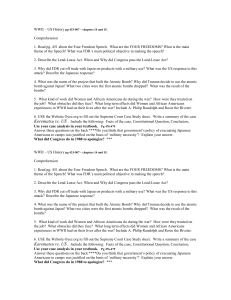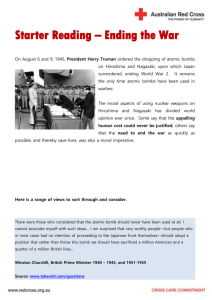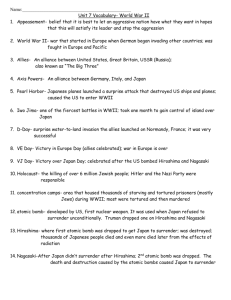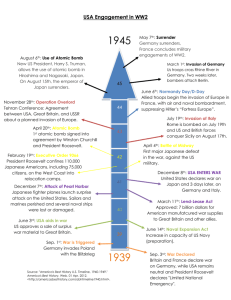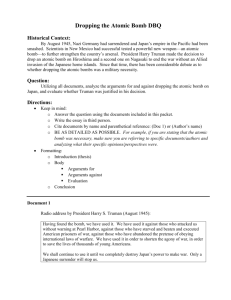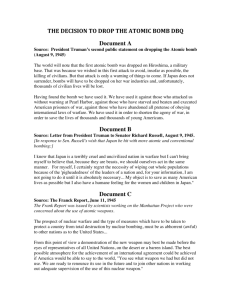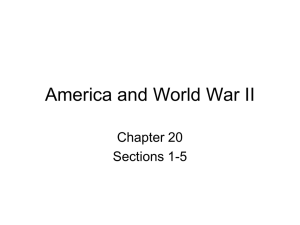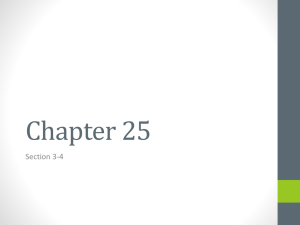Name
advertisement
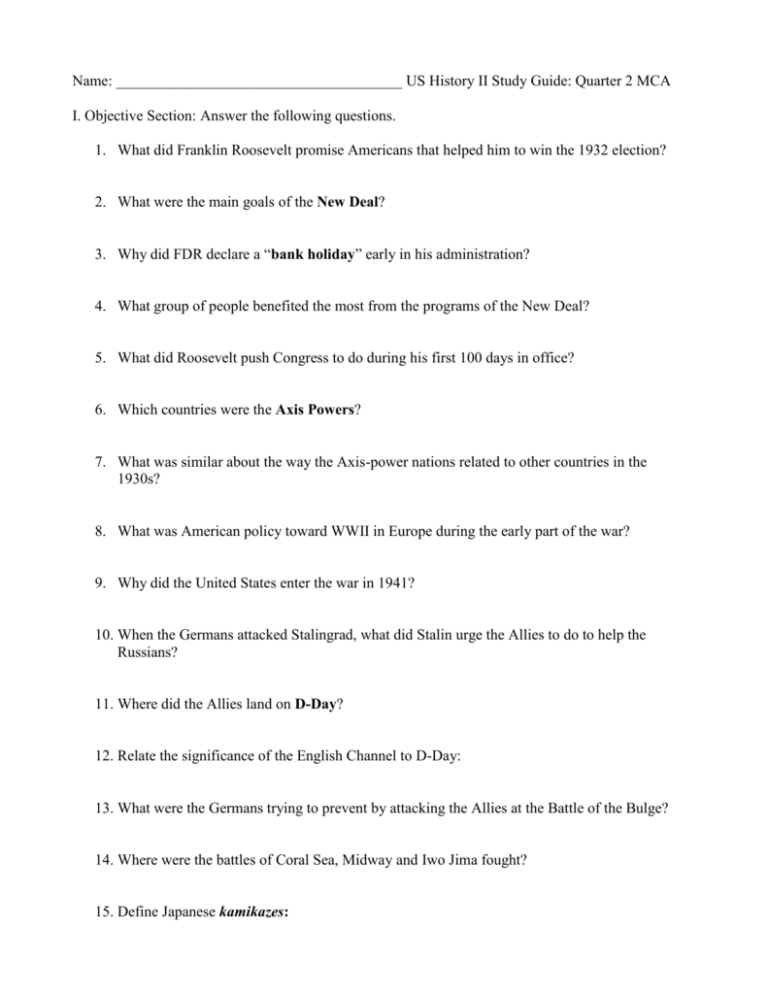
Name: ______________________________________ US History II Study Guide: Quarter 2 MCA I. Objective Section: Answer the following questions. 1. What did Franklin Roosevelt promise Americans that helped him to win the 1932 election? 2. What were the main goals of the New Deal? 3. Why did FDR declare a “bank holiday” early in his administration? 4. What group of people benefited the most from the programs of the New Deal? 5. What did Roosevelt push Congress to do during his first 100 days in office? 6. Which countries were the Axis Powers? 7. What was similar about the way the Axis-power nations related to other countries in the 1930s? 8. What was American policy toward WWII in Europe during the early part of the war? 9. Why did the United States enter the war in 1941? 10. When the Germans attacked Stalingrad, what did Stalin urge the Allies to do to help the Russians? 11. Where did the Allies land on D-Day? 12. Relate the significance of the English Channel to D-Day: 13. What were the Germans trying to prevent by attacking the Allies at the Battle of the Bulge? 14. Where were the battles of Coral Sea, Midway and Iwo Jima fought? 15. Define Japanese kamikazes: 16. Why did the Japanese accept American terms for surrender in August 1945? 17. What were Nazi German efforts to kill all European Jews known as? 18. What did the strategy of island-hopping entail? 19. Why was the Office of War Mobilization created? 20. Name the reasons for the US government’s rationing program in WWII. 21. What is deficit spending? 22. The government used images of young, single women to promote wartime employment for women. But what was the reality of the women who went to work during wartime? 23. In regards to income, how did women compare to men in war production work force? 24. Why did the government evacuate Japanese Americans from the West Coast? 25. How did the United States finally come out of the Great Depression? 26. What did the government expect women to do after the war ended? 27. Why was the United Nations formed? 28. What was the most difficult issue brought up at the Yalta Conference, which worsened relations between the U.S. and Soviet Union? 29. What is a satellite nation? 30. What was the Cold War? II. Written Response Section Complete the following on a separate piece of paper. Answer with as much detail as possible keeping in mind the MCA rubric used for written responses. 1. Identify and explain three ways that Hitler and the Nazi Party maintained control of Germany. 2. Classify at least three sequences of legislation that the United States proposed in its attempt at maintaining neutrality prior to entering WWII. Then identify the event that changed this foreign policy and describe its effect on American opinion regarding entering the war. 3. Provide a detailed summary of at least two major battles of World War II and explain how these battles were turning points/significant in the course of the war. 4. Identify and explain two reasons post-war hostilities developed between the United States and the Soviet Union. III. Document Based Question: On a separate piece of paper read each quote and be able to state the following: Identify main idea: for or against dropping the atomic bomb Provide a quote to support main idea Explain the quote in your own words Quote 1 Source: Memoirs of General H. H. Arnold, Commander of the American Air Force in the Second World War (1949) “The surrender of Japan was not entirely the result of the two atomic bombs. We had hit some 60 Japanese cities with our regular H.E. (High Explosive) and incendiary bombs and, as a result of our raids, about 241,000 people had been killed, 313,000 wounded, and about 2,333,000 homes destroyed. Our B-29’s had destroyed most of the Japanese industries and, with the laying of mines, which prevented the arrival of incoming cargoes of critical items, had made it impossible for Japan to carry on a large-scale war…Accordingly, it always appeared to us that, atomic bomb or no atomic bomb, the Japanese were on the verge of collapse. Quote 2 Source: Memoirs of Secretary of War Henry L. Stimson (1947) “As we understood it in July, there was a very strong possibility that the Japanese government might determine upon resistance to the end, in all the areas of the Far East under its control. In such an event the Allies would be faced with the enormous task of destroying an armed force of five million men and five thousand suicide aircraft, belonging to a race which has already amply demonstrated its ability to fight literally to the death. The strategic plans of our armed forces for the defeat of Japan, as they stood in July, had been prepared without reliance upon the atomic bomb, which had not yet been tested in New Mexico. We were planning an intensified sea and air blockade, and greatly intensified strategic air bombing, through the summer and early fall, to be allowed on November 1 by an invasion of the southern island of Kyushu. This would be followed in turn by an invasion of the main island of Honshu in the spring of 1946. The total U.S. military and naval force involved in this grand design was of the order of 5,000,000 men; if all those indirectly concerned are included, it was larger still. We estimated that if we should be forced to carry this plan to it conclusion, the major fighting would not end until the latter part of 1946, at the earliest. I was informed that such operations might be expected to cost over a million casualties, to American forces alone.” Quote 3 Source: Harry S. Truman, radio address (August 1945) “I realize the tragic significance of the atomic bomb. Its production and its use were not lightly undertaken by this Government. But we knew that our enemies were on the search for it. We know now how close they were to finding it. And we know the disaster which would come to this nation, and to all peaceful nations, to all civilizations, if they had found it first. That is why we felt compelled to undertake the long and uncertain and costly labor of discovery and production. We won the race of discovery against the Germans. Having found the bomb, we have used it. We have used it against those who attacked us without warning at Pearl Harbor, against those who have starved and beaten and executed American prisoners of war, against those who have abandoned the pretense of obeying international laws of warfare. We have used it order to shorten the agony of war, in order to save the lives of thousands and thousands of young Americans. We shall continue to use it until we completely destroy Japan’s power to make war. Only a Japanese surrender will stop us.”
